By John Rousmaniere
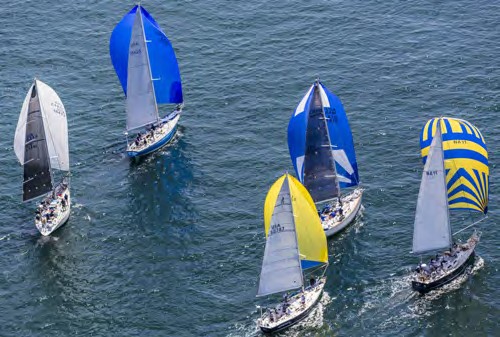 With 200 entries in the 50th Bermuda Race gearing up for the start on Friday, June 17, with boats as varied as the cutting edge 100-footer Comanche and the America replica and a whole range of hard-driving smaller boats, and with a new award for boats with Youth crews that’s named for Olin and Rod Stephens—with all that and more, the 2016 Newport Bermuda Race is on line to be one of those classic events whose future and present are tightly interwoven with its past.
With 200 entries in the 50th Bermuda Race gearing up for the start on Friday, June 17, with boats as varied as the cutting edge 100-footer Comanche and the America replica and a whole range of hard-driving smaller boats, and with a new award for boats with Youth crews that’s named for Olin and Rod Stephens—with all that and more, the 2016 Newport Bermuda Race is on line to be one of those classic events whose future and present are tightly interwoven with its past.
The 50th running of the Newport Bermuda Race starts Friday, June 17. © bermudarace.com
If you aren’t sailing, come to Newport and watch the start or follow the race on the YB tracker linked on the race website, BermudaRace.com. In the meantime, here’s a glimpse of the race’s exciting history.
Winning one Newport Bermuda Race is hard enough, but how do you repeat? Four very different boats have done it over seven decades with a variety of strategies, tactics, and weather, but always with strong crews, careful preparation, and “good admiralship.”
Baruna, 1938, 1948
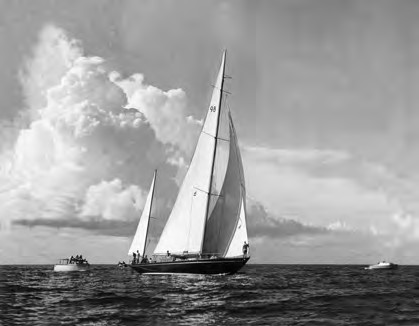 Among the 38 starters in 1938 were the first entry from the U.S. Naval Academy and the new 72-foot Sparkman & Stephens yawl Baruna. Henry Taylor wanted a beautiful boat at the maximum size allowed by the Cruising Club of America Rating Rule that he could cruise and race with his family. After a long thrash, she was first both across the finish line and also on corrected time (a double victory has been attained by just seven boats in the race’s 49-race history). Baruna did it again in 1948 in weather that proved the truth of the saying, “You never know what will happen in a Bermuda Race.” A hard slog through a terrific seaway in the Gulf Stream forced many crews to shorten sail drastically. But Baruna, commanded by young Stillman Taylor, the owner’s son, reached off and boomed along at 9 knots. Her shortest course to St. David’s Light was to leave Bermuda on the port hand (as the rules then permitted), crossing the finish line from south to north, and that’s how Baruna grabbed her second double.
Among the 38 starters in 1938 were the first entry from the U.S. Naval Academy and the new 72-foot Sparkman & Stephens yawl Baruna. Henry Taylor wanted a beautiful boat at the maximum size allowed by the Cruising Club of America Rating Rule that he could cruise and race with his family. After a long thrash, she was first both across the finish line and also on corrected time (a double victory has been attained by just seven boats in the race’s 49-race history). Baruna did it again in 1948 in weather that proved the truth of the saying, “You never know what will happen in a Bermuda Race.” A hard slog through a terrific seaway in the Gulf Stream forced many crews to shorten sail drastically. But Baruna, commanded by young Stillman Taylor, the owner’s son, reached off and boomed along at 9 knots. Her shortest course to St. David’s Light was to leave Bermuda on the port hand (as the rules then permitted), crossing the finish line from south to north, and that’s how Baruna grabbed her second double.
Finisterre, 1956, 1958, 1960
One of Finisterre’s regulars credited her success to Carleton Mitchell’s “good admiralship”— his firm, detail-driven command of a good boat and a loyal crew. Mitchell’s approach was simple and authoritative: “My theory was that the time to get everything right is before you leave the dock. And then, once you leave the dock, to be able to drive the hell out of the boat and never have to worry about something carrying away.” He commissioned Sparkman & Stephens to design the exact opposite of Baruna—a chubby 38-foot centerboard yawl. Finisterre was at her best in a blow, yet did well in fluky winds because (as Olin Stephens said) “her skipper and her crew maintained an almost magical degree of concentration to keep her moving in light airs.” Her trio of Bermuda wins were in the full range of conditions, calms to gales. Mitchell quoted a Bahamian saying about weather, “You eats what the cook serves”: do your best in the conditions at hand.
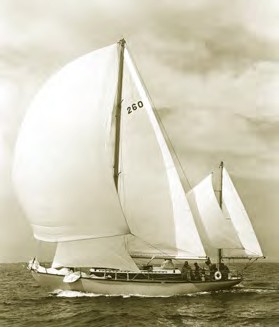 Competition was in Carleton Mitchell’s nature and being. Consider these insightful ruminations (from his book Passage East) about “the somewhat fantastic nature of ocean racing”:
Competition was in Carleton Mitchell’s nature and being. Consider these insightful ruminations (from his book Passage East) about “the somewhat fantastic nature of ocean racing”:
“Here we are, nine men, driving a fragile complex of wood, metal, and cloth through driving rain and building sea, a thousand miles from the nearest harbor; with no one to see or admire or applaud; no one to help if our temerity ends in disaster. . . . Our attitude is not even wholly based on the competitive aspect of racing. It is that we all feel there is just one way to do things, one standard, one code, and we live up to it for our own satisfaction. We are driven by our own compulsions, each personal and secret, so nebulous we probably could not express them to our mates if we tried. But in our own way, we are about as dedicated as it is possible for men to be.”
Little Finisterre spreads all her laundry. © PPL
After the 1960 win, Mitchell and Finisterre went cruising. Quite properly, the Carleton Mitchell Finisterre Trophy is presented to the winner of the Bermuda Race’s Cruiser Division.
Sinn Fein, 2006, 2008
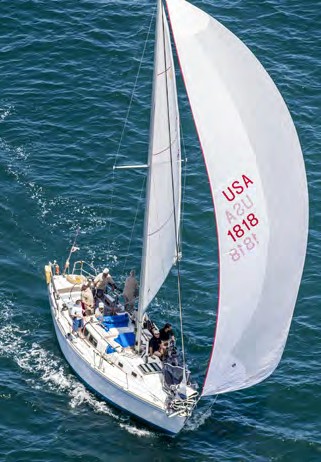 After winning class silver in the 2002 and 2004 Bermuda Races, Peter Rebovich and his sons and friends boys in Sinn Fein, a lightish displacement Cal 40 designed in the 1960s by Bill Lapworth, won the St. David’s Lighthouse Trophy twice in a row—in 2006 in a drifter, and then in a classic thrash. Since then, their record in their class is a solid 2, 2, 3, and they haven’t been worse than eighth in the St. David’s Division. They also won the Olin J. Stephens Ocean Racing Trophy three straight times for the best combined performance in Bermuda Races and Marblehead to Halifax Ocean Races.
After winning class silver in the 2002 and 2004 Bermuda Races, Peter Rebovich and his sons and friends boys in Sinn Fein, a lightish displacement Cal 40 designed in the 1960s by Bill Lapworth, won the St. David’s Lighthouse Trophy twice in a row—in 2006 in a drifter, and then in a classic thrash. Since then, their record in their class is a solid 2, 2, 3, and they haven’t been worse than eighth in the St. David’s Division. They also won the Olin J. Stephens Ocean Racing Trophy three straight times for the best combined performance in Bermuda Races and Marblehead to Halifax Ocean Races.
Sinn Fein won in 2006 and 2008. © Daniel Forster/PPL
Whenever this boat’s name comes up, people speculate about what Princess Anne of Great Britain had to say when she presented the 2006 Lighthouse Trophy to Sinn Fein. “She was very warm and generous,” reports Pete Rebovich. “Anyway, the boat had that name when I bought her back in 1972. I was racing a Comet and I decided it was time to buy a boat I could sail with my sons. I liked the name because it means ‘we ourselves.’” Mark Rebovich and Pete Rebovich, Jr. are the mainstays of their dad’s tight-knit crew, all living near the Raritan Yacht Club in Perth Amboy, NJ. Their spirit carried them through the boat’s near destruction in superstorm Sandy and then the courageous rebuilding project that brought Sinn Fein to the starting line in 2014. Oh . . . she finished third in the St. David’s Division.
Carina, 1970, 2010, 2012
“How did Carina do all that?” was the question of the moment after Rives Potts’ 48-foot sloop won the St. David’s Lighthouse Division in the 2010 Bermuda Race. “All that” included Carina’s whopping big victory margin of more than three and a half hours. This was her second Thrash victory in 40 years. Designed in 1969 by McCurdy & Rhodes for Dick and Richard Nye, Carina promptly won the 1970 Bermuda Race. She continued to do well under the strong command of the Nyes and Potts.
In 2010, Carina fell among calms that left many boats motionless for hours. Potts called what happened next “an accumulation of good decisions and good luck. You always know you’re going to sail into a hole in this race. The question is whether you can get out. Sometimes the stars will turn out right.” Carina’s Patty Young (the first woman to win the George W. Mixter Memorial Trophy for winning navigator) gave three reasons for the boat’s success. First, “We just went with the wind we had rather than going as far as the optimizers said we should.” Second, “We changed to the number 3 at the right time and we rocketed.” And third, “Everybody participated. This was a total team effort.”
Carina proceeded to do a Transatlantic Race, a Rolex Fastnet Race, and then a west-about circumnavigation under the command of the next Potts generation, along the way racing in the Rolex Sydney Hobart Race. After arriving home, she soon headed out to sea again in the 2012 Bermuda Race. After the fast downwind start, Carina joined the 165-boat fleet’s long parade to the favored waypoint marking the entrance to the Gulf Stream. Her crew made five sail changes in the first few hours. (“It’s always good to have boats around you, otherwise you go into cruise mode,” explained navigator Lexi Gahagan.) After the Stream came severe challenges in micrometeorology and racing tactics. Carina played both correctly and won the race, despite taking a time penalty because one of her professional crew was inadvertently allowed to steer.
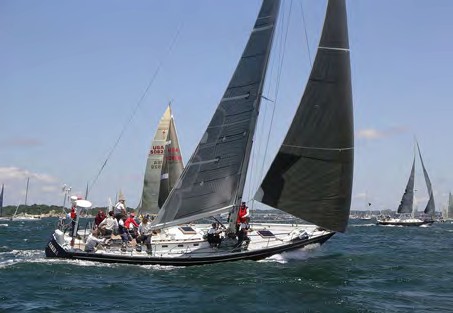 Carina’s adventures were closely followed by the hundreds of sailors who had raced in or against her over four decades. After Sir Richard Gozney, Bermuda’s Governor, presented the 2010 St. David’s Lighthouse Trophy to Rives Potts, Potts invited all present who had ever sailed in Carina to join him at the podium. Within moments, he was surrounded by some two dozen jubilant men and women representing three generations of sailors who had shared in Carina’s story.
Carina’s adventures were closely followed by the hundreds of sailors who had raced in or against her over four decades. After Sir Richard Gozney, Bermuda’s Governor, presented the 2010 St. David’s Lighthouse Trophy to Rives Potts, Potts invited all present who had ever sailed in Carina to join him at the podium. Within moments, he was surrounded by some two dozen jubilant men and women representing three generations of sailors who had shared in Carina’s story.
Carina prepares for 2012’s downwind start off Castle Hill.© John Rousmaniere
The author of The Annapolis Book of Seamanship, Fastnet, Force 10, and other books on seamanship, John Rousmaniere also wrote the Bermuda Race’s history, A Berth to Bermuda.



